Pennsylvania
| |
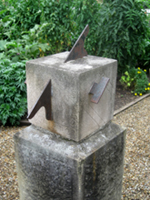 |
Ambridge |
Pennsylvania |
USA |
Polyhedral Dial |
Dial 104 |
| In the garden of Old Economy Village is a 1964 reproduction of the historic 1825 original keep safety indoors. The 9-inch stone dial has four vertical dials on the E,W, N and S sides and one horizontal dial on top. The replica is in fair shape where the engraved hour lines are now severely weathered. The replica five iron gnomons are in fair condition, but still tell reasonably accurate local solar time. Each dial is delineated in half-hour marks with the hours shown in Arabic numbers. |
| |
| |
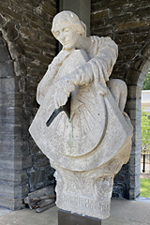 |
Bala Cynwyd |
Pennsylvania |
USA |
Vertical Dial |
Dial 1023 |
| This is a statuary of a saddened maiden leaning over a vertical dial. The hour lines are thick lines radiating from the foot of the gnomon from 5am to 5pm. The maiden's hand lays over the bronze gnomon. In the center of the dial is a compass rose. This may be an 18th century statuary, a cast copy of a dial and statue in London. |
| |
| |
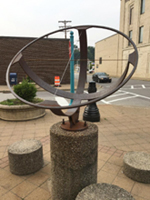 |
Carnegie |
Pennsylvania |
USA |
Equatorial Dial |
Dial 911 |
| Anthony Vitale, a life-long steel worker and internationally know metal sculptor, designed a dial for the place he once worked: Carnegie Steel. He started with a flat length of steel 72 inches long, selected the distance between hour lines to be 6 inches, delineated in 15 minute intervals. The result was an equatorial half-ring 45.836 inches in diameter. He added 3 1/4 inches buffer on each side of the equatorial, creating an outer ring 52 inches in diameter. Along the meridian half-ring, the sun's declination is marked with months when a nodus cross bar casts a horizontal shadow at solar noon. The concrete base can unfortunately be rotated and it seems to point to the magnetic north, but bringing a compass or modern cell phone near the steel armillary instantly creates a distortion. |
| |
| |
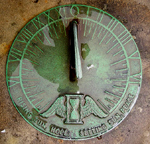 |
Chatham Village |
Pennsylvania |
USA |
Horizontal Dial |
Dial 907 |
| This bronze dial is about 12 inches in diameter. The outside chapter ring is delineated in 15 minute intervals with hours shown in Roman numerals from 4am-8pm. The gnomon has the profile of a bird under the style. Unfortunately the photos show that the gnomon has been installed backward on the dial. At the south end of the sundial is the classic hour glass and wings, symbolizing "Time Flies". |
| |
| |
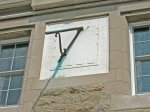 |
Elizabethtown |
Pennsylvania |
USA |
Vertical Dial |
Dial 451 |
| A 4x4 foot marble vertical dial declining 25° east of south with a copper gnomon, located above the center entrance of the Grand Lodge Hall and overlooking the formal garden of the Masonic Village of Elizabethtown. The dial face includes hour lines with half hour and ten minute marks and Roman numerals. An inscription, "ANNO DOMINI MCMXII" is located above the gnomon. The dial declines 25° east of south. |
| |
| |
 |
Farrell |
Pennsylvania |
USA |
Sculpture/Artwork |
Dial 519 |
| "Rising Rings" is a cast iron band 11 feet high by 17 feet in diameter with a hole that casts a beam of light onto a central ring monument on the equinoxes. The dial was commissioned by Dr. Swraj Paul, a steel mill owner, to honor his daughter Ambika who died in 1968 of leukemia at age four. This monument honors the inspiration her joy of life instilled in her father. At the central of the dial is a cast iron ring that holds a bronze image of her that is illuminated for several days twice a year. On two dates, Ambika's birthday and the anniversary of the mill's re-opening the noon sunlight passes through the circular opening in the larger ring and strikes markers on the inner ring. Miklos Simon created the portrait of Ambika mounted on the smaller ring. |
| |
| |
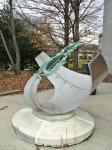 |
Franklin Center |
Pennsylvania |
USA |
Equatorial Dial |
Dial 139 |
| A modernistic equatorial dial about 6 feet in diameter. The analemma shaped gnomon casts standard time onto a wide metal semicircle band. The hours with 10-minute marks are inscribed on the center of the equatorial band. This unique sundial tells the time, indicates the approximate day of the month and projects the zodiacal constellation signs as they are aligned with the sun and the earth in this era. It is accurate to within two minutes. |
| |
| |
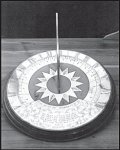 |
Gettysburg |
Pennsylvania |
USA |
Horizontal Dial |
Dial 699 |
| An elaborate gold-colored horizontal dial located on the front lawn of the Eisenhower National Historical Site. The dial was a gift of the National Watch and Clock Collectors. Dial face includes hour lines with Roman hour numerals and a poetic verse describing time. |
| |
| |
 |
Gettysburg |
Pennsylvania |
USA |
Horizontal Dial |
Dial 700 |
| A hexagonal bronze horizontal dial located on the rear lawn of the Eisenhower National Historical Site. The dial was a gift of the Radio and Television Correspondents Association. Dial face includes hour lines with Roman hour numerals and the inscription Tempus Fugit. The dial and a small plaque are mounted on a 120 mm artillery shell. |
| |
| |
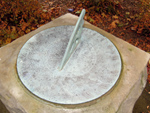 |
Greenville |
Pennsylvania |
USA |
Horizontal Dial |
Dial 912 |
| This bronze dial is about 14 inches in diameter with a coarse near-white patina. Time is delineated in 5 minute intervals from 4:30am to 5:30pm. The hours are marked in Roman numerals and includes a gnomon gap for a fairly thick gnomon. The dial sits on on square stone pillar and thick plinth. Measurement of the gnomon angle agrees with with latitude engraved on the dial plate of 40° 25' that is more than a degree off the latitude of the the dial site. |
| |
| |
 |
Hannover |
Pennsylvania |
USA |
Vertical Dial |
Dial 1131 |
| This is a "virtual" sundial of a horizontal pole near the roof line casting a shadow onto the curved wall in front of the school building.that faces due south. No hour lines or declination lines have been painted on the wall, but there is a shadow "map" indicating where the nodus shadow is throughout the year (see photo #3). As an educational tool, students can create their own map out the time, date and shadow tip on the curved wall. |
| |
| |
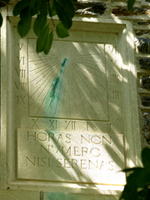 |
Haverford |
Pennsylvania |
USA |
Vertical Dial |
Dial 1022 |
| Not too far up the wall of Union Hall is this vertical rectangular dial about 2x3 foot in size. The limestone dial is embedded in the stone block wall. The declining dial has hour lines every half hour from 5am to 6pm, but the gnomon is missing, leaving only a bronze stain on the light stone face. Most disturbing is a magnolia tree planted by the class of 1972 that now totally blocks sunlight from reaching the dial. |
| |
| |
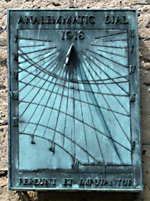 |
Haverford |
Pennsylvania |
USA |
Vertical Dial |
Dial 1021 |
| This bronze vertical dial is about 2x3 feet with a splotched green patina. The hour lines and Roman markers go from 5am to 7pm. The tip of the gnomon shadow shows the date among declination lines from solstice to solstice. It is inscribed as an analemmatic dial, but only because at the noon hour is the trace of the analemma. Considering the motto on the dial, this was probably erected as a memorial to those lost in The Great War. |
| |
| |
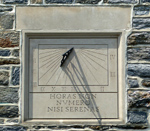 |
Haverford |
Pennsylvania |
USA |
Vertical Dial |
Dial 1020 |
| Vertical dial about 2-foot square high up on the east wing of KINSC. The limestone dial is embedded in the stone block wall. The declining dial has hour lines every half hour from 5am to 4:30pm. The gnomon is in excellent condition and has not left brass stains on the dial face. |
| |
| |
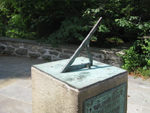 |
Haverford |
Pennsylvania |
USA |
Horizontal Dial |
Dial 1019 |
| A rectangular horizontal dial about 18 x 12 inches. Heavily weathered, but Roman hour lines from 6am to 6pm with noon gap still visible. Original 5 minute hour marks barely visible on rim. The gnomon went missing some years ago and was retrieved on eBay, and is retained by the college. |
| |
| |
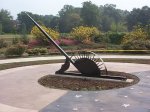 |
Hollidaysburg |
Pennsylvania |
USA |
Horizontal Dial |
Dial 437 |
| This is a large horizontal dial 10 feet in diameter, constructed of marble with a steel gnomon. The sundial was donated in honor of Courtney Leigh Clayton and is open to the public as part of the beautiful Discovery Garden. |
| |
| |
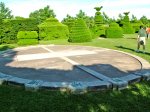 |
Kennett Square |
Pennsylvania |
USA |
Analemmatic Dial |
Dial 328 |
| 37.2 ft x 23.8 ft. This is probably the world's largest analemmatic, unusually designed to show standard time directly. It took 8 years of daily readings to perfect the sundial, which is accurate to within 2 minutes. Hour markers are bronze Roman numerals. Minute lines inscribed in limestone curbing. The gnomon itself is a moveable pole that is set on an AM or PM daily curve. NASS member P. Kenneth Seidelman was instrumental in correcting this design in 1978. |
| |
| |
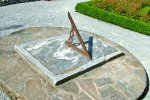 |
Kennett Square |
Pennsylvania |
USA |
Horizontal Dial |
Dial 329 |
| Dating from 1976, this "secret" garden room (once a sundial garden with boxwood parterre) was designed by Thomas Church and is on the western side of the 1908 Square Fountain pool. The ground level horizontal dial is limestone with an iron gnomon. Hour lines identified by Roman numerals; hours divided into minutes. Hour line distribution adjusted for style width. EoT engraved on PM side of dial face. Dial sits atop a large mortared stone base. |
| |
| |
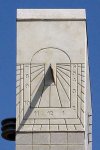 |
Lampeter |
Pennsylvania |
USA |
Vertical Dial |
Dial 545 |
| A 32x64-inch cast stone vertical declining dial located 25 feet up a vertical column at the school's entrance. An EOT plaque is located below the dial. |
| |
| |
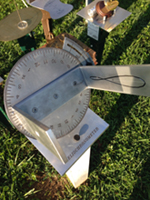 |
Lancaster |
Pennsylvania |
USA |
Heliochronometer |
Dial 875 |
| This 7.5 inch diameter heliochronometer was milled out of aluminum and set to the site latitude with a mounting plate. One heliochronometer arm has a sun illumination counter sunk hole 0.125 inch in diameter and on the other arm an engraved analemma for proper pointing offset to display civil time. Time marks are milled at 5 minute intervals, and a vernier is added (5 lines 4 minutes apart) so that time can be read to the nearest minute. |
| |
| |
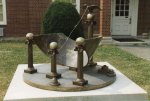 |
Lewisburg |
Pennsylvania |
USA |
Cylindrical Dial |
Dial 445 |
| A large, ornate equatorial dial of brass sits outside the physics department building. The dial is approximately 8 ft (2.4m) across. Two pillars with brass balls support the dial plate. Two more pillars with ball support the gnomon wire. To add a flourish, the north most pillar and ball have a spread eagle holding the gnomon wire in its mouth. Unfortunately this beautiful dial is tarnished by age, with the analemmas for each hour barely visible on the dial plate. The gnomon wire, broken sometime in the past, is jury-rigged and tied together in the middle, resulting in a unkempt look to such a fine dial. A dark, round stone base, perhaps made of slate, approximately 8 ft (2.4) in diameter supports the dial and pillars. The stone sits upon a 10 x 10 ft (3m) concrete pad. |
| |
| |
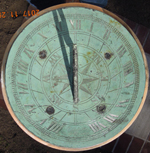 |
Meadville |
Pennsylvania |
USA |
Horizontal Dial |
Dial 906 |
| This patina dial shows lots of wear. Although it sits on an elegant helical pedestal. The dial has a compass rose and from measurements of both the dial and gnomon, it was constructed for London at 51 degrees. This is further supported by the hour extent from 4am to 8pm. The hours are delineated in irregular 5 minute marks with hours shown as Roman numerals. The 6am to 6pm hour lines should be exactly opposite, but are angled toward the gnomon foot. Unfortunately this dial never kept good time in London and certainly can not tell accurate time in Pennsylvania. |
| |
| |
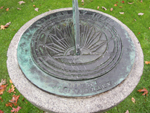 |
Meadville |
Pennsylvania |
USA |
Horizontal Dial |
Dial 905 |
| The sun dial was given to the college in 1909 by the Class of '99 as a memorial on their tenth anniversary. It consists of an elegant bronze dial showing time from 6am-6pm delineated in 15 minute increments. Hours are shown in Roman numerals. The gnomon has the number "99" beneath the style. The dial is mounted on a granite pedestal forty inches in height. |
| |
| |
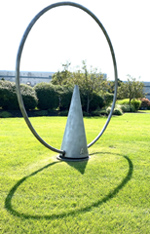 |
Philadelphia |
Pennsylvania |
USA |
Noon Mark or Meridian Dial |
Dial 1017 |
| This meridian dial titled "The Point Where Things Change" was commissioned by the Redevelopment Authority of the City of Philadelphia. It is a large 8-foot (2.4m) diameter hoop aligned north-south. The gray painted hoop is supported at its base, covered by a narrow steel sheet cone also painted gray. The meridian dial and cone are slightly raised above a concrete pad. During the morning the shadow climbs up the AM side of the cone, at noon it rests directly on the point, and in the afternoon it starts to descend down the PM side of the cone. The Redevelopment Authority budgeted $18,000 for the meridian dial as a public art project. |
| |
| |
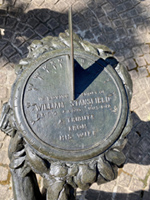 |
Philadelphia |
Pennsylvania |
USA |
Horizontal Dial |
Dial 1016 |
| In a small plaza is a beautiful bronze statue of Pan with Flute. The statue is 36 x 20 x 18 inches. His shoulder is bent to hold a 12-inch bronze sundial. Along the edge of the dial are Roman hour marks from 5am to 7pm. "In 1938, Mrs. William Stansfield presented the bronze statue, “Pan with Sundial,” to the University in memory of her husband, an alum from the class of 1902. The work is by Philadelphia native Beatrice Fenton, a figurative sculptor and portraitist who studied at the School of the Philadelphia Museum of Art and the Pennsylvania Academy of the Fine Arts. Fenton exhibited her work as the 11th member of the “Philadelphia Ten”—a group of women artists—as well as at the Art Institute of Chicago, the 1939 New York City World’s Fair and, in 1976, the Philadelphia Museum of Art. From 1942 to 1953, Fenton taught sculpture at the Moore Institute of Art. |
| |
| |
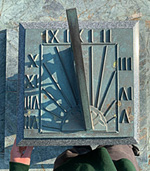 |
Philadelphia |
Pennsylvania |
USA |
Horizontal Dial |
Dial 1047 |
| In the middle of the Girard green in a large central plaza is an impressive stone dais with a square pillar rising several feet. On top is a 12-inch square dial with a smooth green patina. The dial has a wide gnomon offset to point to true north. The most striking thing is the Roman numerals that seem "upside down" from most horizontal dials. The reason is that most observers approach the dial from the north, making the dial easier to read. |
| |
| |
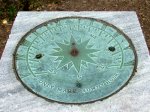 |
Philadelphia |
Pennsylvania |
USA |
Horizontal Dial |
Dial 146 |
| A 10 inch diameter horizontal dial on a 40 inch tall square marble pedestal with dedication plaque. Gnomon is missing. |
| |
| |
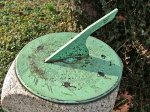 |
Philadelphia |
Pennsylvania |
USA |
Horizontal Dial |
Dial 157 |
| A 1 foot diameter bronze horizontal dial on a square granite pedestal 3 feet tall. Possibly made in 18th century. Beautiful engraving. |
| |
| |
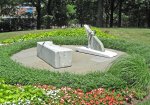 |
Philadelphia |
Pennsylvania |
USA |
Equatorial Dial |
Dial 741 |
| An equatorial projection dial with a 12 inch diameter stainless steel equatorial ring incised with Arabic hour numerals that project onto a grooved central support shaft of Cipollino and Carrara marble set on a bluestone foundation.
A hole near the top of the central marble shaft emits flowing water that runs down the central groove and is recirculated in the warm months. The sundial/fountain marble shaft is 7 inches wide, 36 inches high with a 24 by 55 inch wide base. The dial and nearby Cipollino marble bench rest on a 13-1/2 foot diameter foundation of bluestone pavers set on concrete.
Direct sunlight on the dial is limited by two of the three nearby buildings. In summer with a high elevation sun, sunlight casts gnomon shadows mid-day and for a few hours in the afternoon.
The sundial/fountain sculpture was commissioned by Society Hill Towers in honor of I. M. Pei, Architect of the Towers and was dedicated on the 40th anniversary of the Towers in 2003. |
| |
| |
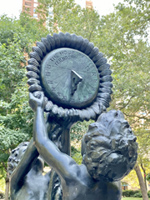 |
Philadelphia |
Pennsylvania |
USA |
Vertical Dial |
Dial 147 |
| Evelyn Taylor Price Memorial Sundial A vertical dial within a bronze sunflower held overhead in the outstretched arms of the bronze sculpture of two children. Dial is a vertical south decliner with hour marks from 6am to 6pm in Roman numerals. |
| |
| |
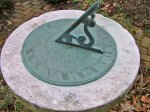 |
Philadelphia |
Pennsylvania |
USA |
Horizontal Dial |
Dial 156 |
| A 1 foot diameter bronze horizontal dial in backyard garden. May be from 18th century. The gnomon is shaky for its bolts are loose. Style angle is about 51deg, an angle for London, not for Philadelphia. |
| |
| |
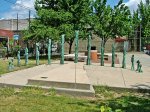 |
Philadelphia |
Pennsylvania |
USA |
Analemmatic Dial |
Dial 158 |
| Analemmatic dial with bronze standing figures. |
| |
| |
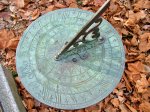 |
Philadelphia |
Pennsylvania |
USA |
Horizontal Dial |
Dial 160 |
| A 1 foot diameter bronze horizontal dial. It was presented by National Association of Watch and Clock Collectors in 1991. However, the style angle is 52deg |
| |
| |
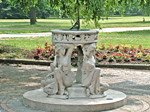 |
Philadelphia |
Pennsylvania |
USA |
Horizontal Dial |
Dial 229 |
| Bronze horizontal dial by Alexander Stirling Calder. Local Hour lines plus EoT monthly corrections and differences between 12 world cities. Tip of gnomon appears damaged. The elegant pedestal sculpture is made of white marble and depicts 4 seated young women as the four seasons holding the dial plinth on their shoulders. The plinth itself is intricately carved with the animals of the zodiac. Height 42-inches, Diameter 50-inches. The dial was a gift of Mrs. Charles P. Turner, through the Fairmount Park Art Association (now the Association for Public Art) to the City of Philadelphia |
| |
| |
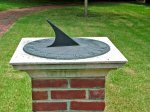 |
Philadelphia |
Pennsylvania |
USA |
Horizontal Dial |
Dial 150 |
| A 21 inch diameter horizontal dial on three foot brick pedestal. Hour lines only. Gnomon reclined. Made in 1989 to commemorate Bicentennial of the General Assembly Presbyterian Church (USA). Visible through locked gates. |
| |
| |
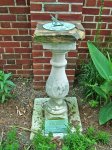 |
Philadelphia |
Pennsylvania |
USA |
Horizontal Dial |
Dial 148 |
| Horizontal dial approximately one foot diameter mounted on old stone atop a 3 foot stone pedestal. It is sitting against north wall of the garden and not aligned in proper direction. Plaque at the base states "This sundial stood for over a century in the gardens of Dorchester House, Park Lane, London, England. Presented by The Soroptomist Club of Philadelphia, December 23, 1935". This may be true for the dial plate because the hour angles indicate a latitude of 51°, the London latitude. It may not be true for the gnomon, whose style angle is 40°, the Philadelphia latitude. Access by taking guided tour, $5; then ask for garden. |
| |
| |
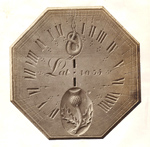 |
Pittsburgh |
Pennsylvania |
USA |
Horizontal Dial |
Dial 641 |
| A 12 inch octagonal carved sandstone horizontal dial with Roman hour numerals from 4 AM to 8 PM. The gnomon is missing. Dial face includes carved figures of a snake and a thistle and is marked latitude 40° 35'. The 1763 date ascribed to the dial's origin is coincident with the relief of the siege of Fort Pitt during Pontiac's Rebellion in that year. The 42nd and 77th Regiments of the Highland Guard and the 60th Regiment of the Royal Americans defeated the Native forces (Delaware, Shawnee, Mingo and Huron Tribes) at the Battle of Bushy Run in August, 1763, successfully quelling the Indian uprising in Southwestern Pennsylvania. The Highland Guard is artistically represented on the sundial by the thistle and the Royal Americans by the snake. Although the assignment of the 1763 date to the dial is not conclusive, the history of Fort Pitt, together with the design elements seen on the sundial and the location of its discovery, provides a plausible conclusion. |
| |
| |
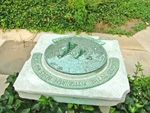 |
Pittsburgh |
Pennsylvania |
USA |
Horizontal Dial |
Dial 107 |
| In May of 1914, a beautiful sundial was erected in Schenley Park in memory of the Pittsburgh Blues, a company sent out from Pittsburgh. To remember this event Pennsylvania Chapters including the Keystone Chapter, Old Ironsides Chapter, General Robert Patterson Chapter, and the Stephen Decatur Chapter participated in the famous grave marking ceremonies which located, honored, and decorated hundreds of graves of men who served in the War of 1812 with custom made flags and flowers. |
| |
| |
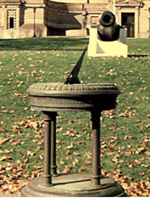 |
Pittsburgh |
Pennsylvania |
USA |
Horizontal Dial |
Dial 436 |
| Horizontal dial about 24 inches in diameter. The stone pedestal is decorated with bronze plaques and Veterans of Foreign War seals on each of the four sides. Now has an open metal base |
| |
| |
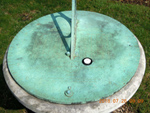 |
Pittsburgh |
Pennsylvania |
USA |
Horizontal Dial |
Dial 108 |
| A bronze and well patina circular horizontal dial about 18 inches in diameter. The dial is delineated in 10-minute increments with Arabic hour numbers. Dial sits atop a plain circular column. The gnomon is plain, secured to the dial plate with four bolts. |
| |
| |
 |
Pittsburgh |
Pennsylvania |
USA |
Sculpture/Artwork |
Dial 909 |
| The memorial is positioned and shaped to capture sunlight through its vertical spaces. While the sun travels the horizon, columns of light shine onto the ground, highlighting words engraved in the stone below that express individual and shared experiences about the war. |
| |
| |
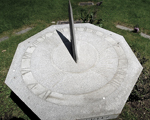 |
Pittsburgh |
Pennsylvania |
USA |
Horizontal Dial |
Dial 908 |
| This granite memorial octagonal sundial is approximately 5 feet across. The top is unadorned, containing only the delineated hour lines in 15 minute intervals and hour marks in Roman numerals from 5am-7pm. The gnomon has a sharp style |
| |
| |
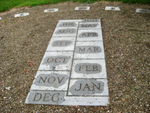 |
Sewickley |
Pennsylvania |
USA |
Analemmatic Dial |
Dial 910 |
| Sewickley is a borough in Allegheny County, Pennsylvania, 12 miles (19 km) west northwest of Pittsburgh along the Ohio River. Riverpark was created in 2010 with a meandering path. At one stop is a plain analemmatic sundial approximately 15 feet across on a gravel bed. Hour markers are granite stones showing 4am-8pm. The analemmatic walkway has engraved abbreviations of the months, looking like granite blocks, but actually clever and beautiful concrete. |
| |
| |
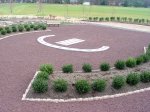 |
Skippack |
Pennsylvania |
USA |
Analemmatic Dial |
Dial 650 |
| A concrete and engraved brick analemmatic dial set in a garden of crushed rock. |
| |
| |
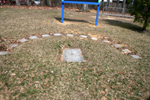 |
State College |
Pennsylvania |
USA |
Analemmatic Dial |
Dial 835 |
| A simple analemmatic dial about 12 feet across. Square unmarked flagstone or pavers mark the hours. The walkway has a concrete base covered by the same flagstone or pavers. The walkway months are embossed in the stone. |
| |
| |
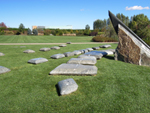 |
State College |
Pennsylvania |
USA |
Horizontal Dial |
Dial 913 |
| The Dr. Joel N. Myers Sundial monumental sundial is truly a masterpiece in time. The 11 foot tall black granite gnomon seems to grow out of a larger granite block. Time is marked by the several rows of low, large flat stones, 25 in all. They are set for summer solstice (first row), equinox (second row that has the stones all in a liner), and winter solstice (only for 10am-2pm. The stones themselves are too large for precise time telling, but the use of colored dots painted on the stones allows you to tell exact civil time using the tip of the sundial's shadow on the solstices and equinox. |
| |
| |
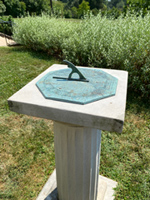 |
Swarthmore |
Pennsylvania |
USA |
Horizontal Dial |
Dial 1018 |
| This octagonal dial was given to Swarthmore in memory of their classmate Howard White Jr. The dial was originally placed in the Scott Arboretum on Parish Lawn but was removed for pathway reconfiguration in 2006. An alum Bob Thompson found that the dial was stored under the bleachers alongside Skallerup Track. n honor of Thompson’s 92nd birthday, the Arboretum returned the sundial placing in in front of Pearson Hall for the next generation of students to enjoy. |
| |
| |
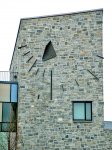 |
Swarthmore |
Pennsylvania |
USA |
Vertical Dial |
Dial 35 |
| Modern design for a vertical dial declining 20.5 deg east on a stone block wall. The gnomon is a right-angled sheet of bronze, casting shadows onto granite hour marks from 6am to 4pm. The dial was designed by Marti Cowan using Waugh's formulae for vertical dials. Frederick Orthlieb, professor and chair of the Dept of Engineering at Swarthmore "had a part in locating the bent-plate gnomon so as to give correct indications on the vertical wall. As installed, the gnomon's indicating edge (which lies on a Polar Axis) casts quite a short shadow in Autumn and Winter and requires some observing skill to make a close estimate of indicated time, but in Spring and Summer the longer shadow moves over the granite hour marks very plainly." A double-line mark at 11am indicates noon during Daylight Saving Time. The second mark is slightly askew if one looks carefully. |
| |
| |
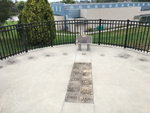 |
York |
Pennsylvania |
USA |
Analemmatic Dial |
Dial 1132 |
| This analemmatic sundial is in a circular plaza about 20 feet (6m) in diameter. The dial has Arabic numbers 6am to 6pm, centered on 12 noon with no longitude correction (only about 7 minutes of time). The zodiac walkway is unusual in that it reverses the left-right position of June and July, simulating the analemma figure 8 pattern. The adjoining plaque implies that by standing slightly left or right of the zodiac center line, you can adjust your shadow time to show civil time. |
| |